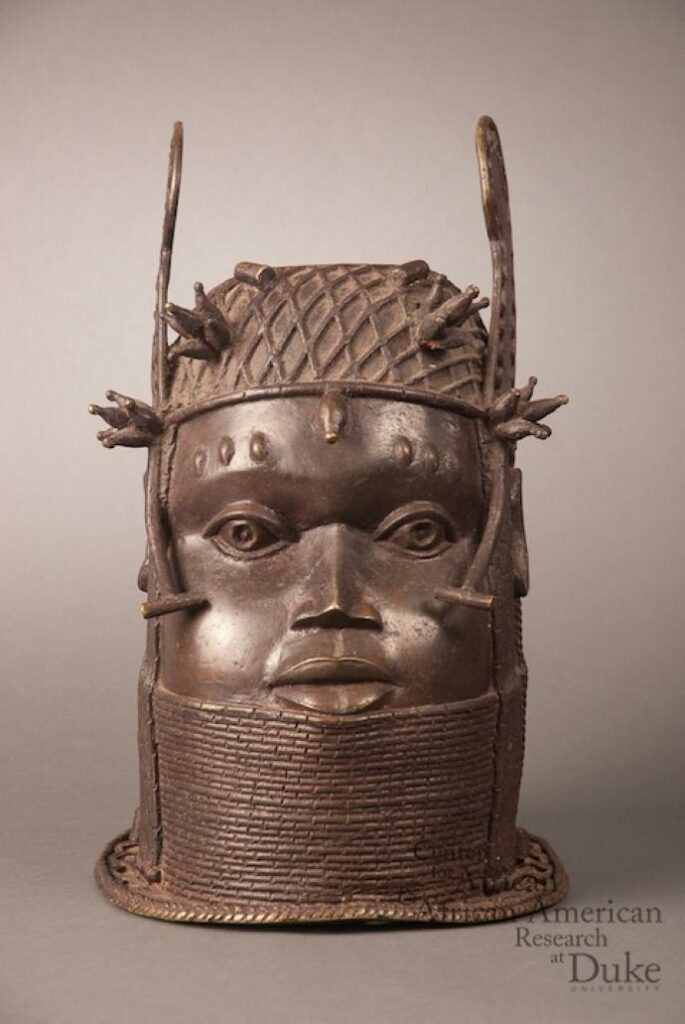This exhibition focuses on the differences, the similarities, and the historical communication among West African Yoruba religion and its most celebrated American cognates—Brazilian Candomblé and Cuban Santería/Ocha. The Collection was assembled with an eye toward similarities of form and meaning among the sacred objects of these traditions, as well as similarities of meaning amid differences of form and similarities of form amid differences of meaning. Of special interest are once locally distinctive and sometimes recently developed forms and meanings that traveled, long after the end of the Atlantic slave trade, from one Yoruba-Atlantic setting to another or have been appropriated from European, Chinese, Indian, Native American, or non-Yoruba West African sources.
If this cosmopolitan Yoruba-Atlantic civilization spread through circum-oceanic migration and commerce, once could also describe, for equally heuristic purposes, a cosmopolitan and multi-ethnic West African civilization that developed through riverine, overland, and particularly circum-Saharan migration and commerce. The translocal mobility, commerce, and empire-building of Mande-speakers, Hausa people, and Fulani people have affected large swathes of the region bounded by the Sahara on the north, the Atlantic on the east and the south, and Cameroon on the west.
This region has been a major exporter and importer of culture. Beginning about three millennia ago, the ancestors of today’s Bantu-speakers, who dominate the linguistic landscape of sub-equatorial Africa, originated in what is now eastern Nigeria, spreading their agricultural and pastoralist way of life into regions previously occupied by hunters and gatherers. For two millennia, the great trade cities of the Sahel, Djenne-Djeno being the oldest among them, have been conduits of cultural influences among West Africa, the Mediterranean, and a ring of societies that border the Great Afro-Asiatic Desert extending from what are now eastern Senegal to northwestern China. Nearly a millennium ago, the trans-Saharan trade brought Islam and phonetic writing to West Africa, which spread in tandem the mobility of the Mande-speakers, the Hausa, and the Fulani. Many West Africans belong to Sufi brotherhoods, such as Qadiriyya, Tijaniyya, and Muridiyya, the last of which was founded by a Senegalese Toucouleur, or Fulani, cleric named Amadou Bamba (1850-1927). The capital of the Muridiyya is Touba, Senegal, but many members of this third and newest of the major West African Sufi brotherhoods—the Mourides—are today found in Western cities conducting trade for the benefit of their families and of their religious leaders at home.
For the past half-millenium–first through the trade in gold, leather, spices, and human chattel and, then, through colonization–West Africa adopted European administrative styles, added American cultigens such as corn, cassava, and tomatoes to its cuisine, incorporated Christianity into its range of lifeways, and became even more integrated as a region through the European-style motor transportation.
The convergence of these intra- and inter-regional movements of people, goods, and ideas have produced a highly recognizable set of regional architectural, sartorial, culinary, religious, and artistic styles. With respect to sculpture, music, and religion, West Africa has much in common with West-Central Africa. For example, the two regions are equally famous for their vivid wooden carvings of gods, heroes, and sacred animals, either as stand-alone figures or as danced masks. Between the regions, there are some shifts in emphasis—such as the relative importance of ancestor-veneration, as opposed to non-ancestral gods, in West-Central African, as well as the greater importance of animal sacrifice in West African religious practice. Among the forest and savannah peoples of West Africa, power-packed ceramic pots and other vessels figure prominently in the ritual making of people. In West-Central Africa, it is power-packed bags and effigies with power-packed body cavities that play this role.
Islam penetrated West Africa far earlier and deeper, and Islam is an element of the legacy that West Africans carried with them to the Americas. For example, the second-largest African revolt in the Americas, after the Haitian Revolution, was the Malê Revolt of 1835 in Bahia. It was led by Yoruba and Hausa Muslim captives and freed people. Unconsciously commemorating the once-sizable African Muslim presence in Bahia, many Bahians—particularly the Candomblé devotees among them—dress in all-white clothing on Fridays, the Islamic Sabbath. However, it is the least or most recently Islamized populations of West Africa that had the most enduring influence on the Afro-Atlantic religions.
Among these are the people known today as the Fon, the Ewe, the Akan-speakers (such as the Ashanti), the Igbo, and the Yoruba. The magnificent bronze- or brass-casting traditions of the Benin Empire and of the Akan-speakers seem to have no counterparts in the Americas. Neither do the initiatic and masquerade traditions of the Senufo and of the Bundu and Sande societies in present-day Liberia, Sierra Leone, and Guinea-Conakry. However, some extant and some extinct sacred masquerades in Brazil and Cuba have been identified with the Gęlędę and Egungun masquerades of the Yoruba.

